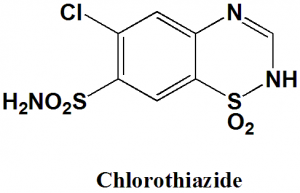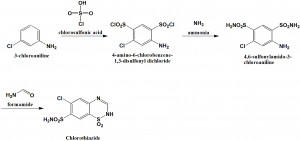CHLOROTHIAZIDE Synthesis, SAR, MCQ,Structure,Chemical Properties and Therapeutic Uses
Chlorothiazide
IUPAC nomenclature
6-chloro-1,1-dioxo-2H-1,2,4-benzothiadiazine-7-sulfonamide
Classification
- Thiazide diuretic
Physiochemical Properties
| S. NO. | PHYSICAL AND CHEMICAL PROPERTIES | |
| 1 | Molecular weight | 295.7 g/mol |
| 2 | Physical appearance | White crystalline powder |
| 3 | Melting point | 342.5oC |
| 4 | Solubility | Freely soluble in dimethylformamide; practivally insoluble in ether; soluble in water |
| 5 | Octanol/water partition coefficient | -0.24 |
| 5 | Presence of ring | Benzothiazine |
| 6 | Number of chiral centers | Not present |
Mechanism of Action
- Chlorothiazide prevents active chloride reabsorption at the early distal tubule through the sodium chloride contransportor which results in an increase in the excretion of sodium, chloride and water from the body.
- The drug also binds with thiazide-sensitive Na-Cl transportor and prevents sodium ion transport across the renal tubular epithelium. This increases the potassium excretion through Na-K exchange mechanism.
- It can also mediate its actions on carbonic anhydrase in the smooth muscle or on the large-conductance KCa channel found in smooth muscle.
Structure Activity Relationship
General structure activity of thiazide diuretics can be summarized as:
- Chlorothiazide is the simplest member of the series.
- Hydrogen atom at the 2-N is most acidic due to presence of electron-withdrawing group.
- Sulfonamide group at C-7 position provides additional acidity to the drug.
- Electron withdrawing group is essential at position 6 for diuretic activity of the drug.
- Substitution on hydrogen at 6 position gives little diuretic activity, whereas, substitution with chloro and trifluoromethyl groups gives highly active compounds.
- Substitution of electron donating group at position 6 significantly reduces the diuretic activity.
- Replacement or removal of sulfonamide groups from position 7 significantly reduces the diuretic activity.
- Saturation of the double bond to give 2,4-dihydro derivative are 10-folds more active than the unsaturated compounds.
- Substitution of a lipophillic group at 3 position increases the potency.
- Substitution with the entities such as haloalkyl, aralkyl or thioether gives compounds with longer duration of action due to increased lipid solubility.
- Alkyl substitution at the 2-N position can increase the action duration. [1]
Method of synthesis
i. Sulfonylchlorination of 3-chloroaniline using chlorosulfonic acid to produce 4,6-sulfonochloride-3-chloroaniline.
ii. The last is reacted with ammonia to give 4,6-sulfonylamido-3-chloroaniline.
iii. Heating of the above formed compound with formamide produces chlorothiazide drug.[2]
Medicinal Uses
Chlorothiazide is used for:
- Management of hypertension
- Management of edema related to heart failure
- For increasing effectiveness of other antihypertensive drugs in severe
Side Effects
Side effects of chlorothiazide are:
- Headache
- Lightheadedness
- Dizziness
- Blurred vision
- Spinning feelings
- Diarrhea
- Constipation
- Stomach cramps
- Stomach upset
- Muscle spasms
MCQs
Q.1 What can be the correct IUPAC nomenclature of Chlorothiazide?
a) 6-chloro-1,1-dioxo-2H-1,2,4-benzothiadiazine-7-sulfonamide
b) 1,4:3,6-dianhydro-2,5-di-O-nitro-D-propanol.
c) 1-[(4-Chlorophenyl)(phenyl)methyl]-4-methylpiperazine
d) 1-[(4-Chlorophenyl)(phenyl)methyl]-4-ethyliperazine
Q.2 Which amongst the following statements is/are correct related to the SAR of thiazide diuretics?
I. Chlorothiazide is the simplest member of the series.
II. Hydrogen atom at the 2-N is most acidic due to presence of electron-withdrawing group.
III. Sulfonamide group at C-7 position provides additional acidity to the drug.
a) I, III
b) II, III
c) I, II
d) I, II, III
Q.3 The correct order for the synthesis of drug Chlorothiazide from 3-chloroaniline can be?
I. Intermolecular dehydration
II. Sulfonylchlorination
III. Reaction with ammonia
IV. Heating with formamide
a) I – IV
b) I – II
c) III – II
d) II – III – IV
Q.4 Side effects of drug Chlorothiazide is/are?
a) Headache
b) Diarrhea
c) Muscle spasms
d) All of the above
Q.5 Match the following drugs with their correct Octanol water partition coefficient-
| i. Chlorothiazide | A. -0.24 |
| ii. Cimetidine | B. 5.8 |
| iii. Azatadine | C. 3.59 |
| iv. Meclizine | D. 0.4 |
a) i-C, ii-B, iii-A, iv-D
b) i-C, ii-A, iii-D, iv-B
c) i-A, ii-D, iii-C, iv-B
d) i-A, ii-C, iii-B, iv-D
Q.6 An example of drug from class Thiazide diuretic?
a) Chlorothiazide
b) Amphetamine
c) Alprazolam
d) Isosorbide dinitrate
Q.7 The type of ring system found in the structure of drug Chlorothiazide is?
a) Dihydroopyridine
b) Benzothiazine
c) Phenyl
d) Pyrimidine
Participate in Online FREE GPAT TEST: CLICK HERE
Participate in Online FREE Pharmacist TEST: CLICK HERE
Participate in Online FREE Drug Inspector TEST: CLICK HERE
Participate in CSIR NET JRF Mock Test
ANSWERS
1-a
2-d
3-d
4-d
5-c
6-a
7-b
REFERENCES
[1] Lemke TL, Williams DA, editors. Foye’s principles of medicinal chemistry. Lippincott Williams & Wilkins; 2012 Jan 24. [2] Vardanyan R, Hruby V. Synthesis of essential drugs. Elsevier; 2006 Mar 10.

